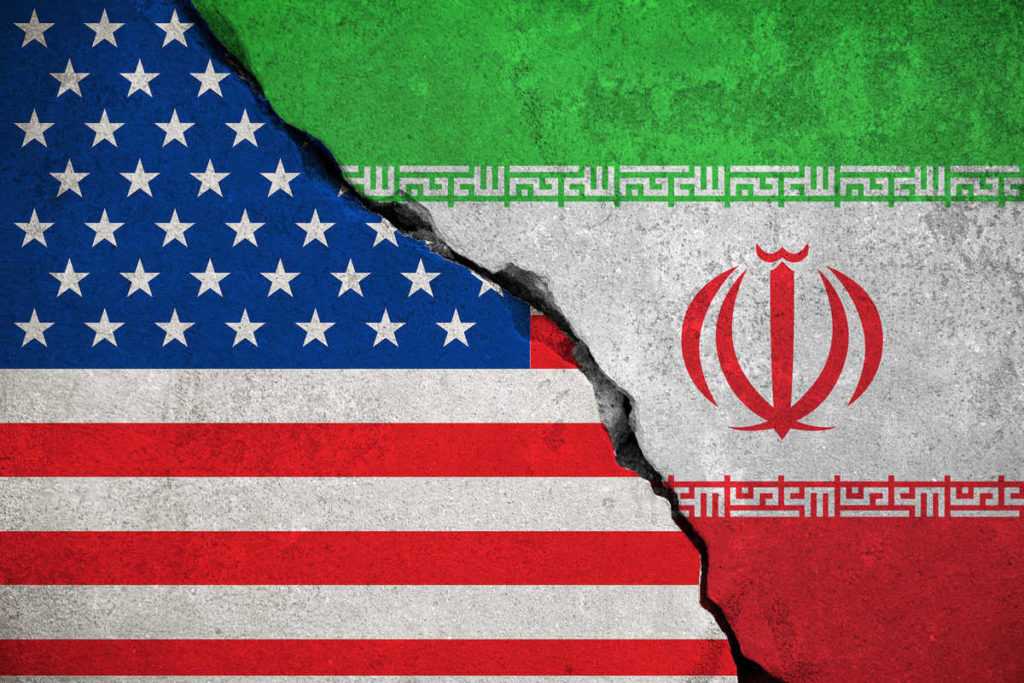Turning the corner against Iran’s terror militias
There should never have been any doubt that the Iranian regime would return to direct strikes against American targets. Years of IED carnage against Americans and Coalition troops in Iraq by Qods Force-commanded militias elicited nothing more than gag orders on the U.S. soldiers who came home maimed.

iranian flag on broken wall and half usa united states of america flag, crisis trump president and iran for nuclear atomic risk war concept
There should never have been any doubt that the Iranian regime would return to direct strikes against American targets.
It got away with the 1983 Beirut Embassy and Marine Corps barracks bombings; overtly allying with Usama bin Laden in Khartoum in 1990; Khobar Towers (1996), the East Africa Embassy bombings (1998); the USS Cole attack (2000); and eventually the attacks of 9/11, too — with nary a peep of protest, much less any sort of retaliatory strike from any one of four U.S. presidents.
Years of IED carnage against Americans and Coalition troops in Iraq by Qods Force-commanded militias elicited nothing more than gag orders on the U.S. soldiers who came home maimed.
So, when a different sort of president won the White House in 2016, while not really knowing who Donald J. Trump would be, the Iranians still saw no reason to be concerned.
After all, they’d just pulled off the biggest scam in the history of U.S.-Iranian relations with the fraudulent nuclear deal, topped off by $1.7 billion in cash that enabled the ruling mullahs and their hired guns in the IRGC (Islamic Revolutionary Guard Corps), Qods Force, Bassij and MOIS (Ministry of Intelligence and Security) to ramp up both their nuclear weapons program and financial support for a slew of jihad terror groups across the region.
Israel knew what was going on because it had to defend against an incessant barrage of border attacks, rockets, missiles, and terror tunnels from north and south.
Then, in May 2018, President Trump took the U.S. out of the Iran nuclear deal and began incrementally to re-impose sanctions against the Iranian regime. It’s called a campaign of “maximum pressure” and while it placed a certain amount of financial strain on Tehran’s budget, it was not possible to deter an aggressive jihadist regime with mere financial measures.
Popular uprisings in Iran, Iraq, and Lebanon were annoying, of course, but nothing the Qods Force commander, MG Qassem Suleimani, couldn’t handle with the Supreme Leader’s command to use lethal force that took thousands of lives and counting.
U.S. Secretary of State Mike Pompeo tweeted that the U.S. stood with the protesters, but they saw no evidence of it. In Lebanon, where citizens from all sectors of society — Druze, Shi’ites, Sunnis — were openly clamoring for reform minus Hizballah, the December 2019 release of over $100 million in U.S. military aid to the Lebanese Armed Forces was seen as funding to an Iranian satrap run by an Islamic terror organization.
Throughout 2019, Iranian attacks against commercial shipping, Saudi oil facilities, and even a U.S. drone elicited nothing more than some more sanctions and discussion about renewing negotiations with the mullahs. Tehran was on a roll and it seemed no level of instigation could prompt anything more threatening to the regime itself than a few tweets.
Naturally, Tehran upped the ante: why not? U.S. credibility and deterrence, from its perspective, were non-existent.
By mid-December 2019, rockets were falling on military bases in Iraq where U.S.-led coalition forces were stationed.
The culprits were Iran-backed Shi’ite terror militias.
That seemed to get the attention of U.S. Secretary of Defense Mark Esper and Chairman of the Joint Chiefs of Staff Gen. Mark Milley, who testified before Congress on December 11, 2019.
They talked about how Iran shouldn’t “mistake U.S. restraint for unwillingness to respond with decisive military force should our forces or interests be attacked.”
Acting U.S. Navy Secretary Thomas Modly registered a bit more alarm on December 27 when he warned that “There’s nothing that suggests to me, short of a regime change there, that you have a different tone set from the leadership, that would suggest to me that they’re going to stop doing what they’ve been doing.”
Secretary Pompeo also warned that any Iranian attack harming U.S. personnel would draw a “decisive U.S. response.”
The mullahs must not have gotten the message, though, because two days later, an American citizen contractor was killed and U.S. military personnel injured by a rocket barrage targeting the Kirkuk, Iraq, military base where they were posted.
Iran’s Shi’ite terror proxy Kata’ib Hezbollah was identified as responsible and the same night of December 29, the U.S. finally launched air strikes against at least five of its command posts and weapons depots in both Iraq and Syria. This is a good start.
As Caroline Glick pointed out in her December 27 column, it is time to face the true nature of this Iranian regime, the one detailed in its constitution.
There is no internal struggle between “moderates” and “hard liners.” There is only a unified, brutal, and ruthless enemy that will not stop its aggression until forcibly stopped — by us. By Israel and the U.S. No one else can and no one else will. If we wait much longer to tangibly support the Iranian, Iraqi, and Lebanese people in their quest to shake off Tehran’s oppression, we will all be confronted with a nuclear-armed regime.
Time for regime change. Faster, please, as Michael Ledeen might say.
- Did Wuhan coronavirus escape from a lab in China? - January 27, 2020
- Iran’s red flag of war flies over Jamkaran - January 10, 2020
- Turning the corner against Iran’s terror militias - January 2, 2020
